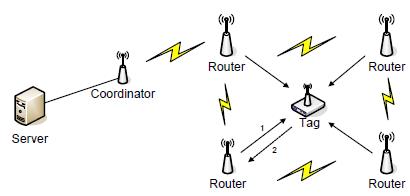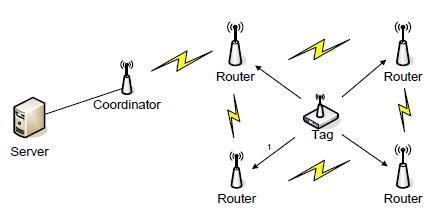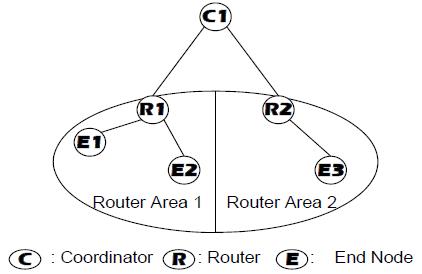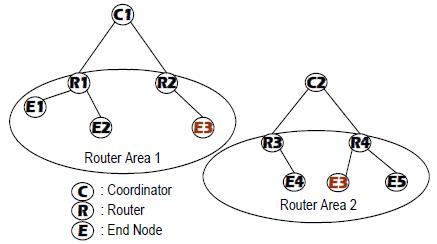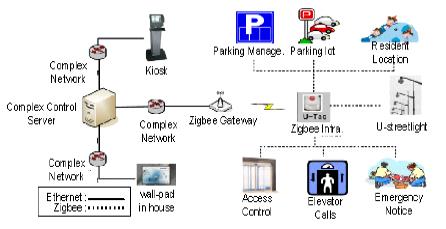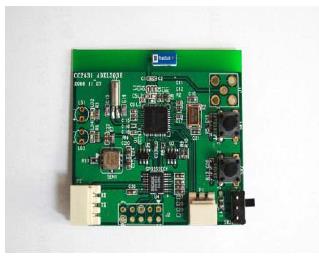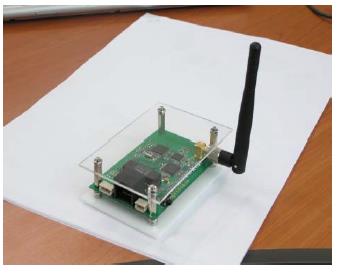
A hand-off mechanism of mobile nodes in a location positioning system based on ZigBee tags
Location awareness is one of the key functions to build an U-city. Recently, many of works for the location-aware systems are emerging to be applied to on-going large-scale apartment complex. For example, when dwellers or cars with active tags are move in the apartment complex, the active tags broadcast their own identifiers periodically and receivers such that routers use this information to calculate the location of the active tags.
Since the active tags can actually move between routers and coordinators, it requires a hand-off mechanism. In this paper, we investigate the hand-off problem occurred in location awareness system based on ZigBee active tags. We propose and analyze a new approach for handling the hand-off problem. Through a mathematical analysis, we show that our approach diminishes the quantity of packet transfer than ZigBee's approach.
Keywords:
ZigBee Tag, Location Awareness, RSSI, Vehicle Location Awareness, Resident Location Awareness1. Introduction
ZigBee [1] is one of the key technologies to realize U-city. The main characteristics of ZigBee can be counted low cost and low power consumption. We can use for more than several months or a couple of years with small sized battery such as AA type alkaline battery. And the cost of it is very cheap by three or four dollars now.
Because of these advantages, ZigBee is applied to various communication applications especially to change existing wired sensor network to be wireless and is getting into the spotlight in new radio applications. ZigBee is also studied into location positioning system of resident or vehicles recently and it is near step at commercial application.
Research on location awareness began to get attention with entrance on the stage of radio communication and many research results have been achieved in various field. The cellular phone with GPS is used for a long time [2][3]. The location awareness techniques based on RSSI (Received Signal Strength Indication) is generally used because it can recognize location only by strength of RF's power without any other special devices [4]-[8].
To recognize the location of residents or vehicles in apartment complex for realizing U-city, the system satisfies the following requirements. First, it must be able to use in indoor environment such as underground parking lot as well as outside environment. Next, a tag has to be wearable or attachable. So it should be light and simple. Finally, It can be in error by less than several meters but power consumption is very important so that can be used for more than several months by small sized battery.
To satisfy these requirements, we propose a RSSI-based location awareness techniques using ZigBee tag. The proposed system is simple, satisfied with required low power consumption, and proper to required error range because it uses RF only. However, as ZigBee tag across routers or coordinators this causes a hand-off problem that happens to be stopped in communicating between them.
To solve this hand-off problem, ZigBee standard [9] suggests reunion or path-search technique. But, they make another problem to leave dregs on address table in router or to spread path search packets over the network.
In this paper, we propose a new algorithm to solve the hand-off problem that is happened by a location awareness system based on ZigBee tag and RSSI. The proposed algorithm does not use the existing reunion method or path search technique. And we show that the technique pares down more greatly packet transmission burden than existing methods.
In Chapter 2, we describe related researches and define hand-off problem in moving terminal nodes and propose a solution in Chapter 3. Implementation and analysis of location awareness system is explained in Chapter 4. Finally, we describe conclusions and further research directions in Chapter 5.
2. Related Works
2.1 Location awareness technique based on RSSI
Location awareness becomes a fundamental function in the mobile communication area. It is to position target objects outdoor and/or indoor. GPS satellites are used for outdoor objects for a long time. And location awareness methods on mobile communication network is widely used which utilize response time interval between mobile phone terminal and surrounding base station transceiver system.
Location awareness techniques based on RSSI is also studied a lot because they can recognize the location of the target object by power level of RF without special device addition. In case of RADAR [4] system, it measures location with the radio strength of the known beacon nodes and its error range is in several meters. For the mobile network without beacon nodes, there are also a lot of researches. Moving object sends a signal and fixed receiving apparatus recognize the signal strength and then compute the location of sender [5][6][8].
These methods are based on signal strength, but the algorithm which calculates location is different from each other. Elnahrawy presented experimental result that location awareness system based on RSSI has fundamentally considerable amount of error range [6].
2.2 Signal Transmission Methods for Location Awareness
The location awareness based on RSSI is classified into two types according to who transmits signal. First, the router whose location is fixed and well known to all moving tags sends beacon signals, the moving nodes receive and then analyze the signals for computing the their own positions. RADAR [4] used this method. The CC2431 chip [12] developed by Texas Instrument had a location awareness engine supporting for this method.
Second, the moving node broadcasts beacon signal, and the fixed routers receive it and central computer decides the location of the node[5][6].
Figure 1 shows the former method that recognizes the location of target tag node with signal strengths transmitted by routers. Routers transmit beacon signals periodically and a target node may receive these signals. And then the tag node calculates its own location and sends it to router, finally server receives tag's location. To recognize correctly, tag node needs m signal packets from routers and there must be packets received from more than three routers.
Figure 2 shows the latter method that tags transmit the signal packets to recognize the location. The moving tags broadcast signal and routers which receive the signal transmit the RSSI to server. As well as former method, tags broadcast m signal packets for reducing error range.
Sun-Sup So and Seongbae Eun [10] show these approaches recognize successfully the location of tags in the apartment complex and the efficiency of them is different depending on the density of tags. When the density of tags is high, the former method to recognize with signals transmitted by routers is more efficient. In the case of low density of tags, the former method to recognize with signals transmitted by tags is more efficient.
2.3 Hand-off Processing Technique in ZigBee
The current ZigBee standard does not provide any algorithm to solve the hand-off problem caused in a inter-router or inter coordinator [9]. To solve the problem in ZigBee standard, the re-connection method or path search method is used.
As shown in Figure 3, 'R1' and 'R2' routers exist in 'C1' coordinator area and end tag node 'E2' is currently connected to router 'R1'. If tag node 'E2' moves into router ‘R2’ area, then 'E2' requires hand-off to the router 'R2'.
ZigBee Standard’s re-connection method can be used for this example and the algorithm is as follows:
① 'E2' moves router ‘R2’ area physically.
② End-node 'E2' transmits data to 'R1' continuously, but 'E2' does not receive any ACK from ‘R1’ and ‘E2’ become aware of disconnecting from network.
③ 'E2' broadcasts 'Orphan Request' packet to confirm which router has its own record in ZigBee’s Network Address Table
④ If 'E2' receives no reply to 'Orphan Request', then 'E2' broadcasts 'Beacon Request' to the whole network.
⑤ Receiving replies to 'Beacon Request' from all surrounding routers, 'E2' selects the nearest router and transmits 'Association Request' to the router. It may be ‘R2’.
⑥ When 'R2' receives 'Association Request' from 'E2', 'R2' adds the address of 'E2' in its own Address Table and then sends 'Association Response' to 'E2'.
When the step ⑥ is finished, a network re-connect is completed. This re-connection method based on ZigBee standard has a severe shortcoming. This method requires robust address management technique because address of end-node which already moved out still remains in the Address Table of previous routers'.
A hand-off problem among ZigBee WPANs is more difficult. As show in Figure 4, we suppose there are two WPANs that are managed by coordinator ‘C1’ and ‘C2’, respectively. Generally, there is no mechanism for exchanging data between WPANs. Even though end node 'E3' moves from coordinator 'C1' area to 'C2' area, they cannot recognize the moving of tag node ‘E3.
For the location awareness system in apartment complex, hand-off problem among coordinators have to be solved because several ZigBee WPANs can be furnished for an apartment complex.
3. Proposed Hand-off Method
3.1 Requirements for Location Awareness System in Apartment Complex
Through requirement analysis for the location awareness system of apartment complex, we can design a structure of ZigBee network. We are based on the case of considerably large scale of apartment complex in South Korea. The requirements derived are as follows:
① Tag supports uplink communication to send signals for location to routers as well as downlink communication for receiving control information and updating modules remotely. In the frequency of communication, Uplink is very high but downlink is rare.
② The size of apartment complex is supposed to more than hundreds house and hundred square meters. Therefore, the network system should be consisted of several number of ZigBee WPANs. It means that hand-off between routers and hand-off between coordinators can happen at the same time.
③ Only one server manages for a apartment complex.
④ The sensor network for location awareness system should be composed to comply with the ZigBee standard.
⑤ We use the method to recognize with signals transmitted by routers according to the analysis of[6].
⑥ It must be able to aware location every 5 seconds.
3.2 Solution for Hand-off Problem
In this paper, we propose a new solution for inter-router and inter-coordinator hand-off problem. The proposed solution can overcome the shortcomings of ZigBee standard’s approaches such that reunion or path search techniques for inter-router hand-off problem. And more, the solution solves the inter-coordinator hand-off problem.
Under the assumption that the target apartment complex consist of fixed number of coordinators areas (PANs), the proposed hand-off technique is as follows.
① All element of each PAN such that coordinator, router, and end node have unique network identification number. ID number 0 is assigned to each coordinator and another unique ID number is assigned to each end node by system administrator. On the other hand, routers are given with a suitable ID automatically whenever routers connect to a coordinator according to ZigBee's Network address assignment convention.
② Routers broadcast periodically their location signal. At that time, coordinator area (PAN) ID is transmitted in piggyback. End nodes listen to router's signal until 4 or 5 times of transmission interval for confidence about receiving signal.
③ Each end-node calculates its own location based on received signals from routers. When end node transmits its calculated location to coordinator, it uses coordinator area (PAN) ID in piggyback.
④ To transmit the calculated own location to coordinator, end-node communicates with the router which have the biggest RSSI among available surrounding routers.
In step ①, the most important point is that end node’s ID is not a PAN-wide unique number but a whole network-wide unique number. It is for the feature of end node which can move to and from all PANs. And the end node ID numbers are always bigger than router's ID number.
In step ②, because end-node must communicate after it receives location signal from routers, delay time have to be analyzed for satisfying 6th requirement. If router’s transmission interval is 100ms, then the maximum delayed time is just a bout 400~500ms and it can satisfy the condition to aware location every preset 5 seconds.
In step ③ through transmitting PAN ID in piggyback with its location signal, we can get rid of burden of broadcasting PAN ID.
In step ④ end-node transmits the calculated location packet to a router having the biggest RSSI and then the router also transmit the received location packet to the relevant coordinator.
4. Implementation and Analysis
4.1 Implementation of Proposed System
The Figure 5 shows the conceptual structure of the proposed location awareness system for apartment complex. The residents and cars have active tags known as U-tag. The routers broadcast its own ID by periods and the U-tags which receive this data recognizes its location on comparing the RSSIs of routers. Recognized location information is saved in server through apartment complex network and accessed by kiosk, wall-pad terminal and so on.
As shown in Figure 5, major modules of proposed system are tag, router and gateway. We describe each component shortly. The implemented tag is shown in Figure 6. To implement the tag, ATmega128 for MCU and cc2431 that support 2.4GHz ZigBee standard for RF module are used. Antenna is PCB antenna with 3 mercury cell batteries. Moreover, acceleration sensor is used to support low-power consumption mode when the tag is not moving.
Figure 7 shows the router implemented. This router is designed to communicate with tags by ZigBee standard and with coordinator by TCP/IP protocol. Routers are fixed at designated spot with ordinary power.
The routers transmit periodically location signals to tags, and then tags measure and return RSSIs with signals sent from routers. Routers again transmit them to the central server. The central server calculates the location of the tag based on these RSSI values.
4.2 Analysis of Proposed Technique
To analyze the proposed hand-off technique, there are several assumptions as follows:
① Cost caused by broadcasting of PAN ID is not considered. It is because router transmits PAN ID in piggyback when it send location signal.
② We consider only uplink location signal packets that end-node sends to coordinator. There is no transmission packet between end-nodes or between routers, and downlink control packets from coordinator to routers and end nodes are very rare.
③ It is supposed that probability of no response to Orphan Request is p.
For hand-off based on re-connection method, two or four additional packets are needed when end node moves to another router or coordinator. When an end node cannot receive location signal from the previous communicated router any longer, the node suspects to be out of the router and tries to connect to the nearest router.
As we describe in section 2.3, the node transmits an Orphan Request. If there are responses from routers for the Orphan Request, these two packets only for the request and response are needed. But, if there is no response, two packets for a 'Beacon Request' and an 'Association Request' are additionally needed.
With the 3rd assumption, we can represent the amount of additional packets for hand-off under re-connection method as follows:
On the other hand, our proposed technique needs no additional cost for hand-off. End-node receives coordinator area (PAN) ID from router and can always recognize its own coordinator area (PAN). There is no additional packet because tag transmits its own location signal directly to relevant router without re-establishment of path. Therefore, our proposed technique is more effective than existing methods.
5. Conclusion and Futher Research Direction
In this paper, we define and analyze the problem caused when tags move between routers or coordinators in the location awareness system based on ZigBee tag. For the system that use the method which routers send beacon signals, we show that our techniques for hand-off is more efficient than existing methods based on total transmission of packet through the mathematical analysis.
The location awareness technology that follows 802.15.4a based on UWB is recently commercialized. Development of hand-off technique under the UWB is research direction hereafter in location awareness system.
References
- ZigBee Alliance ITU-T, NGN overviews, ITU-T SG 13 Recommendation, September), (2004.
- Texas Instrument, CC2431 Location Engine, http://ti.com Accessed March 24 2011.
- K. Pahlavan, K. Krishnamurthy, A. Hatami, M. Ylianttila, J. Makela, R. Pichna, and J. Vallstrom, “Handoff in hybrid mobile datanetworks”, IEEE Personal Communications Magazine, 7(2), p34-47, (2000).
- P. Bahl, and V. N. PadManabhan, “RADAR: An in-building RF-based user localization and tracking system, Proceedings of Infocom, (2000).
- P. Corke, R. Peterson, and D. Rus, “Networked robots: Flying robot navigation using a sensor net”, Proceedings of Infocom, (2001).
- E. Elnahrawy, X. Li, and R. Martin, “The limits of localization using RSSI”, Proceedings of International Conference on Security, (2004).
- J. H. Sung, T. W. Lim, J. S. Kim, S. G. Park, and D. H. Seo, “An improvement algorithm for location using adjacent node and distance variation analysis techniques in a ship”, Journal of the Korean Society of Marine Engineering, 37(2), p213-219, (2013).
-
H. J. Cho, G. I. Hwang, D. S. Noh, and D. H. Seo, “Real time indoor positioning system using IEEE 802.15.4a and sensors”, 36(6), p850-856, (2012).
[https://doi.org/10.5916/jkosme.2012.36.6.850]

-
S. Dagtas, G. Pekhteryev, and Z. Sahinoglu, “Multi-stage real time health monitoring via ZigBee in smart homes”, Proceedings of IEEE International Conference on Advanced Information Networking and Applications Workshops (AINA Workshops), p782-786, (2007).
[https://doi.org/10.1109/AINAW.2007.263]

- Sun Sup. So, Seongbae. Eun, “Design and implementation of a location positioning system based on ZigBee tags in apartment,”, Journal of IEEK-TC, 44(10), p13-19, (2007).
